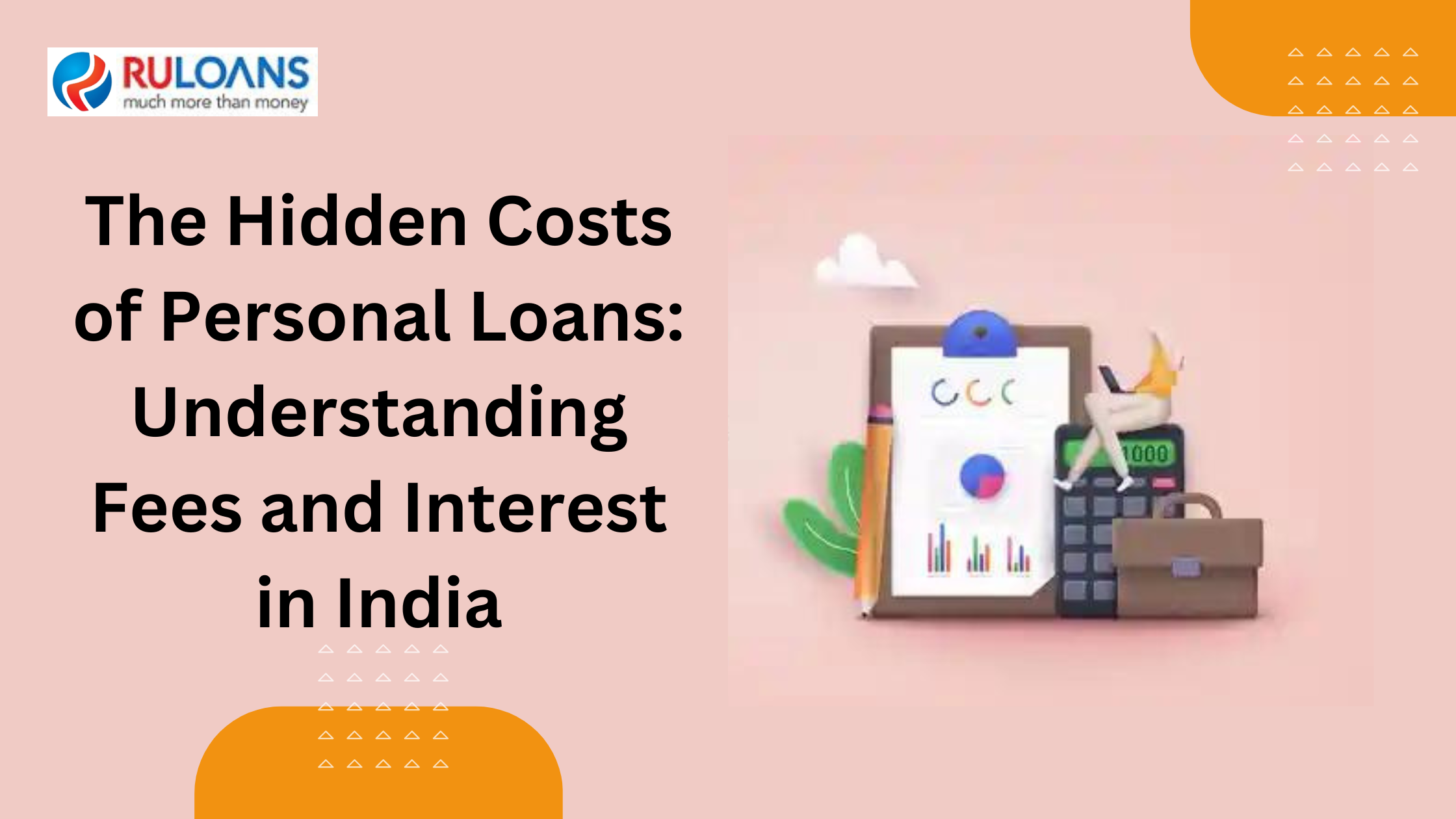In India’s rapidly growing economy, an increasing number of individuals are turning to personal loans to meet their financial needs. Whether it’s for a medical emergency, a wedding, home renovation, or just to bridge a short-term cash flow gap, personal loans offer a flexible financing solution. However, like all financial tools, personal loans come with their set of costs, some of which may not be immediately obvious. In this blog, we’ll delve deep into the hidden charges associated with personal loans in India and help you make an informed decision.
Introduction
A personal loan, in simple terms, is a sum of money borrowed from a financial institution that needs to be repaid with interest over a specified period. Unlike a car loan or home loan, which is secured against an asset, personal loans are typically unsecured, meaning you don’t have to provide any collateral. The repayment happens in the form of monthly installments, and the interest rate is either fixed or variable, depending on the lender’s terms and conditions.
Why is it crucial to understand the hidden costs? Simply put, what seems like a convenient financial solution at first glance can end up being more expensive than anticipated if one is not aware of all associated fees. This knowledge ensures that you’re not caught off guard and can budget effectively for your loan repayment.
Types of Personal Loan Fees
Let’s break down the various fees associated with personal loans:
- Application Fee: This is a one-time fee charged at the outset by the lender to process your loan application. While some lenders might waive this fee to attract customers, others might incorporate it into the cost of the loan. It’s essential to ask about this upfront and factor it into your borrowing costs.
- Origination Fee: Also known as a loan setup fee, this is charged by the lender to cover the costs of processing and underwriting the loan. It’s typically a percentage of the loan amount. Some lenders might offer loans with no origination fees, but they might compensate for that with a slightly higher interest rate.
- Prepayment Penalty: If you find yourself in a position to pay off your loan earlier than the stipulated time, you might think it’s a cause for celebration. However, some lenders charge a prepayment penalty. This fee is their way of compensating for the interest they won’t be receiving because of the early payoff. It’s always a good idea to check if your loan comes with such a penalty.
- Late Payment Fee: As the name suggests, this fee is levied when you miss an EMI (Equated Monthly Installment) or delay it. This fee can vary from lender to lender. Regularly missing payments can also affect your credit score adversely.
- Processing Fee for Electronic Payments: In today’s digital era, many prefer to make their payments electronically due to the convenience it offers. However, some lenders might charge a nominal fee for this service. It’s essential to be aware of such fees, especially if you plan to pay electronically.
- Other Fees: Apart from the charges mentioned above, lenders might have other fees tucked away in the fine print. For instance, some might charge a document fee for the paperwork involved, while others could have a wire transfer fee if you’re receiving your loan amount through a wire transfer. Always make it a point to go through the loan agreement carefully and seek clarification on any fee you’re uncertain about.
How to Avoid Hidden Costs in Personal Loans
- Taking out a personal loan can be a strategic financial move when faced with sudden expenses or when looking to consolidate debts. However, as we’ve explored previously, there can be several hidden costs associated with personal loans. It’s crucial to ensure that these unforeseen expenses don’t negate the benefits of the loan. Here are some proactive steps to avoid getting caught off guard:
- 1. Compare Loan Offers: One of the most straightforward ways to avoid excessive fees is by shopping around. Different lenders have different fee structures, and by comparing loan offers, you can identify which one provides the best value for money. Utilize online loan comparison tools, consult with financial advisors, or even rely on personal research to gather this information.
- 2. Read the Fine Print: While this might sound cliché, many borrowers overlook the details in their loan agreements. The fine print often contains information about fees and penalties that may not be prominently advertised. Ensure you go through all terms and conditions diligently, understanding each clause.
- 3. Ask Questions: Never shy away from asking questions. If there’s any fee or clause you don’t understand in the loan agreement, seek clarification from the lender. This proactive approach can save you from unexpected costs later on.
- The Impact of Interest Rates on Personal Loans
- Interest rates play a pivotal role in determining the overall cost of a personal loan. It’s the price you pay for the privilege of borrowing money. A lower interest rate can save you significant amounts in the long run, while a higher rate can greatly increase the cost of the loan. Let’s delve deeper into this:
- 1. What is an Interest Rate? Simply put, the interest rate is expressed as a percentage of the loan amount, representing the cost of borrowing. For example, if you take out a ₹1,00,000 loan with a 10% annual interest rate, you will pay ₹10,000 as interest over one year, excluding other fees and charges.
- 2. The Cost Implications: The higher the interest rate, the more you will pay in interest over the life of the loan. For instance, on a ₹1,00,000 loan with a 5-year term, an interest rate of 10% will cost significantly more than an interest rate of 7%. Over the span of the loan, this difference can amount to a considerable sum.
- 3. Comparing Personal Loans: When comparing personal loan offers, it’s crucial not just to look at the interest rate, but also the APR (Annual Percentage Rate). The APR combines the interest rate with any fees or additional costs associated with the loan, giving you a clearer picture of the total cost. This can be particularly helpful in evaluating loans where one has a slightly lower interest rate but higher fees, or vice versa.
Tips for Getting the Best Personal Loan Deal
A personal loan, when utilized well, can be a lifeline during challenging financial times. Yet, securing the best deal on a personal loan is a combination of research, preparation, and negotiation. Whether you’re a first-time borrower or have taken out loans in the past, there are always ways to enhance your chances of getting favorable terms on your loan. Here are some top tips to ensure you secure the best deal:
1. Maintain a Healthy Credit Score:
Your credit score is a testament to your financial discipline and reliability. Lenders rely heavily on credit scores to gauge the risk involved in lending to a particular individual. Typically, a higher score (closer to 900, as per the CIBIL score system in India) indicates a history of timely repayments and responsible credit behavior. Borrowers with higher scores are often offered loans at lower interest rates. Thus, ensure you pay your EMIs and credit card bills on time, keep your credit utilization ratio low, and regularly check for inaccuracies in your credit report.
2. Shop Around:
With a multitude of banks, non-banking financial companies (NBFCs), and online lending platforms offering personal loans in India, the market is ripe for comparison. Different lenders may offer varying interest rates, fees, and loan terms. Leveraging online comparison tools, reading reviews, and even consulting with a financial advisor can provide you with a clearer perspective. Remember, it’s not just about finding a lender, but about finding the right lender for your needs.
3. Negotiation is Key:
While it might seem that the terms of a loan offer are set in stone, there’s often room for negotiation. Especially if you have a good credit score, steady income, and a long-standing relationship with a financial institution, you have leverage. Don’t hesitate to discuss the possibility of lower interest rates or reduced fees with your potential lender. Even a slight reduction can result in significant savings over the loan’s tenure.
4. Consider a Cosigner for Added Assurance:
If your credit history is less than stellar or if you’re a first-time borrower with no credit history, getting a favorable loan offer can be challenging. In such situations, bringing in a cosigner can make a difference. A cosigner is someone who agrees to repay the loan if you’re unable to. Essentially, they provide an added layer of security for the lender. This arrangement can be beneficial if the cosigner has a good credit score and a stable income. However, remember that this is a significant responsibility for the cosigner, so ensure you have open communication with them about the loan terms and your repayment plan.
Conclusion
Personal loans have grown in popularity in India, offering a flexible financing solution to myriad needs, from medical emergencies to home renovations. Yet, it’s clear that taking out such a loan isn’t a straightforward affair. Beyond the amount borrowed, several hidden costs, fees, and interest intricacies can significantly affect the total repayment amount. While personal loans can be an excellent financial tool, ensuring that you’re getting the best deal requires diligence, research, and a proactive approach to understanding and negotiating the terms.
Key Takeaways:
- Understanding is Crucial: Before diving into a personal loan, one should understand not only its apparent costs but also the hidden fees and charges that could be embedded in the agreement.
- Interest Rates Matter: The interest rate isn’t just a percentage; it can be the difference between a manageable repayment plan and a financial burden. Always factor in the total interest over the loan’s life when calculating its true cost.
- The Power of Negotiation: While loan terms might seem fixed, there’s often room to negotiate, especially if you present yourself as a reliable borrower. Whether it’s a reduction in fees or a slightly lower interest rate, every bit can result in substantial savings.
- Cosigners as a Safety Net: If you’re struggling with a not-so-great credit history, a cosigner can tip the balance in your favor. However, it’s essential to remember the significant responsibility they’re taking on, ensuring you communicate effectively and have a solid repayment strategy in place.
- Due Diligence is Rewarding: By investing time in comparing loan offers, reading the fine print, and maintaining a healthy credit score, you position yourself to secure the best possible deal on your personal loan.









